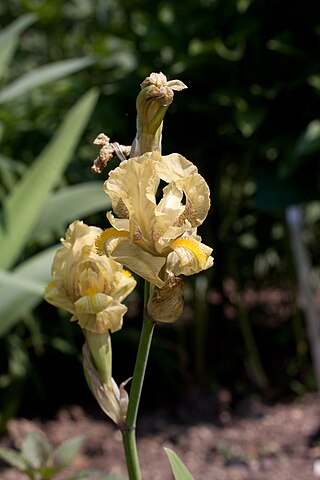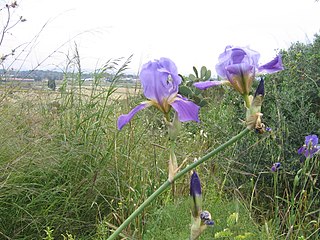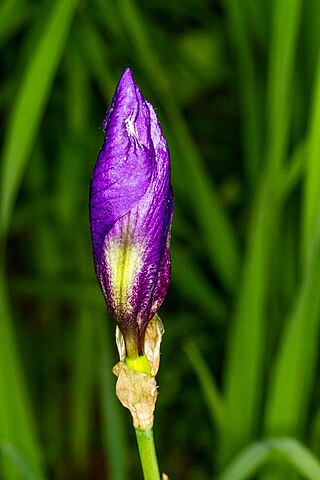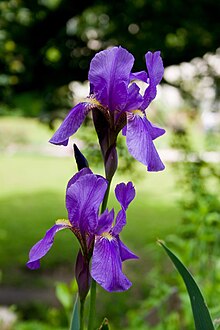
Iris × germanica is the accepted name for a species of flowering plants in the family Iridaceae commonly known as the bearded iris or the German bearded iris. It is one of a group of hybrid origin. Varieties include I. × g. var. florentina.
Iris falcifolia is a plant species in the genus Iris, it is also in the subgenus Iris and in the section Hexapogon. It is a rhizomatous perennial, from Uzbekistan, Kazakhstan, Afghanistan, Iran and Pakistan. It is a small plant, with sickle-shaped greyish-green leaves, lilac-violet flowers and darker veining, and a white or yellow beard. It is cultivated as an ornamental plant in dry, temperate regions.
Iris dolichosiphon is a plant species in the genus Iris, it is also in the subgenus Iris and in the section Pseudoregelia. It is a rhizomatous perennial, from China and Bhutan. It has long, thin dark green leaves, very short stem, and dark blue, purple, or violet flowers. That are mottled with white. It has thick white/orange beards. It has one subspecies, Iris dolichosiphon subsp. orientalis, from China, India and Burma. It has similar flowers. They are cultivated as ornamental plants in temperate regions

Iris aphylla is a species in the genus Iris, it is also in the subgenus Iris, and in the section Iris. It is a rhizomatous perennial, from Asia to Europe. It is found in Azerbaijan, Russian Federation, Czech Republic, Germany, Hungary, Poland, Belarus, Ukraine, Bulgaria, Albania, Former Yugoslavia, Italy, Romania and France. It has dark green or bright green, sword-shaped, long grass-like leaves, that die/fade away in the winter. It also has a slender stem, with several branches and green and purplish spathes. It has 3–5 large flowers, in shades of bright purple, purple, violet, dark blue, blue-violet and dark violet, which bloom between spring and early summer. Occasionally, they re-bloom in the autumn, before the seed capsule is formed. It is cultivated as an ornamental plant in temperate regions. There is one known subspecies Iris aphylla subsp. hungarica Hegi.
Iris adriatica is a plant species in the genus Iris, it is also in the subgenus Iris. It is a rhizomatous perennial, from the Dalmatia region of Croatia in Europe. It has short sickle shaped leaves, small stem and flowers that vary from yellow to purple or violet. It is rarely cultivated as an ornamental plant in temperate regions.
Iris cypriana is a plant species in the genus Iris, it is also in the subgenus Iris. It is a rhizomatous perennial, from Cyprus. It has narrow, glaucous and evergreen leaves, tall slender stem, with 2–3 branches, and 1–3 large flowers in lavender, lilac, red-lilac, to dark purple shades. It is cultivated as an ornamental plant in temperate regions. It is listed in some sources as a synonym of Iris germanica.

Iris furcata, the forked iris, is a plant species in the genus Iris, it is also in the subgenus Iris. It is a rhizomatous perennial, from the Caucasus mountains, in the countries of Moldavia and the southern Ukraine. It has short, narrow, sword-shaped leaves. A slender stem, that branches beyond the midpoint, holding small purple, deep purple, blue-violet, light blue or violet flowers. It is cultivated as an ornamental plant in temperate regions. It is often regarded as a synonym of Iris aphylla, but it has chromosomal and morphological differences, so it may considered to be a parent species instead.

The identity of the plant first described by Carl Linnaeus as Iris florentina remains unclear, as of December 2021. In horticulture, it has been treated as a white-flowered variant of Iris × germanica, under names such as Iris germanica nothovar. florentina, Iris × germanica var. florentina and Iris × germanica 'Florentina'. Iris florentina has also been treated as the correct name for the true species also known as Iris albicansLange.
Iris hellenica is a plant species in the genus Iris and the subgenus Iris. It is a rhizomatous perennial, from Saitas Mountain, in the Peloponnese Region of Greece. It has grey-green, sickle-shaped leaves, a tall slender stem, 2–3 white, lavender-blue, lilac or purple flowers and orange/purple beards. It was thought once to be a hybrid species of Iris germanica which also grows in the same area, before being separated into 2 species. It has only recently been published and is rarely cultivated as an ornamental plant in temperate regions.

Iris imbricata is a species in the genus Iris, it is also in the subgenus Iris. It is a rhizomatous perennial, from the Caucasus mountains, within Iran, Armenia, Azerbaijan and Georgia. It has broad, sword-like, yellow green or light green leaves, slender stem with branches, inflated and overlapping green spathes, and 2–5 yellow, pale yellow or greenish yellow flowers.

Iris junonia is a plant species in the genus Iris, it is also in the subgenus Iris. It is a rhizomatous perennial, from Cilicia, within the Taurus Mountains. It has glaucous short leaves, tall stems with several branches, numerous flowers in various colours from blue-purple, lavender, pale blue, cream, white and yellow, with brown veining and white tipped orange beards. It is cultivated as an ornamental plant in temperate regions. Its status is still unclear, if it is a synonym of Iris germanica or a separate species.

Iris marsica is a plant species in the genus Iris, it is also in the subgenus Iris. It is a rhizomatous perennial, from the Apennine Mountains, in Italy. It has glaucous, sickle-shaped or curved, light green leaves, slender stem with 2 branches, and 3 violet, light blue violet, dark violet, and dark purple flowers. It was only found and described since 1973, and is not yet in general cultivation. It was once thought to be a form of Iris germanica, but has different morphological characteristics and different chromosomal differences.

Iris mesopotamica, the Mesopotamian iris, is a species in the genus Iris, it is also in the subgenus Iris. It is a rhizomatous perennial, from the middle East, within the countries of Iraq, Turkey, Syria and Israel. It has linear, grey-green or green broad leaves, tall stem with 2–3 branches, holding up to 9 scented flowers, in shades of violet, purple, lavender blue and light blue, with a yellow and white or orange and white beard. It is listed as a synonym of Iris germanica in some sources. It is cultivated as an ornamental plant in temperate regions, including being planted in graveyards and cemeteries but may also be used for celebrations and decoration.

Iris pallida subsp. cengialti is a subspecies in the genus Iris, it is also in the subgenus Iris. It is a rhizomatous perennial, from Italy and Slovenia. It has yellowish-green, glaucous, lanceolate or ensiform leaves, tall stem, green flushed with purple spathes, 2 short branches, 2–3 scented flowers, in shades of violet, blue-violet, deep purple, blue-purple, deep blue-purple, pale purple, deep blue, to mid-blue. It has a yellow or orange tipped beard. It was originally published as Iris cengialti but then re-classified as a subspecies of Iris pallida, and known as Iris pallida subsp. cengialti, but it is often still called Iris cengialti. It is cultivated as an ornamental garden plant in temperate regions.
Iris perrieri is a plant species in the genus Iris; it is also in the subgenus Iris. It is a rhizomatous perennial, from the Savoy Alps in southern France and recently in Italy. It has green, deeply ribbed, sickle shaped leaves, a slender stem with a branch, 1–3 scented flowers that are violet or purple, with a white or pale blue beard. It is rarely cultivated as an ornamental plant in temperate regions, due to its rarity in the wild. It was once thought to be a form of Iris aphylla, before cell (chromosome) analysis determined it to be a separate species.

Iris pallida subsp. illyrica, synonym Iris pseudopallida, is a subspecies of Iris pallida. It is a rhizomatous perennial from Croatia. It has flat, curved of sickle-shaped leaves, tall slender stems, 3–8 fragrant flowers, in shades of violet, or pale violet flowers, mauve, lavender, purple, yellow or white, between May and June. The iris was originally thought to be a separate species, but later classified as subspecies of Iris pallida, although in Croatia, it is still known as Iris pseudopallida. It is cultivated as an ornamental plant in temperate regions, especially in the Balkan regions.
Iris relicta is a plant species within the genus Iris, and it belongs to the subgenus Iris as well. This rare rhizomatous perennial originates from the mountains of Italy. It is of medium size, bearing purple flowers adorned with white beards. While it is seldom cultivated as an ornamental plant in temperate regions, its history has been perplexing. Initially mistaken as a variety of Iris germanica, it was later recognized as a distinct species, though it shared a name with another bearded iris. The clarification of its taxonomy only occurred in 1996.

Iris sambucina, the elder scented iris, is a plant species in the genus Iris, it is also in the subgenus Iris. It is a rhizomatous perennial, from southern and central Europe. It has green, curved or sword-like leaves, tall round stem, multiple flowers in shades from brown violet, or brown-purple, to purple-violet, blue violet, mauve, and to purple. The large flowers are fragrant, with the scent of elderflowers, hence the name. It was first considered a separate species, then it was classified as a synonym of Iris germanica, before being classified as a separate species again, but with a hybrid origin from Iris pallida and Iris variegata. It is sometimes cultivated as an ornamental plant in temperate regions.
Iris setina, the iris of Sezze, is a species in the genus Iris, it is also in the subgenus of Iris. It is a rhizomatous perennial, from a small region in Italy.It has glaucous sword-like leaves, slender branched stem, and one or two violet toned flowers. It is not yet cultivated as an ornamental plant in temperate regions.

Iris subbiflora is a plant species in the genus Iris, it is also in the subgenus Iris. It is a rhizomatous perennial, from Portugal and Spain in Europe. It has evergreen broad leaves, forming dense clumps, it has dwarf stems in late spring,, with 1 upright fragrant flower, in shades of purple, light red purple, grey-blue, blue-violet, or dark violet. It has a beard which is generally blue, purple, or violet, but can fade to white, dull yellow, or dark yellow. After being found in 1804, it was once a separate species until the late 70s, when it was reclassified as subspecies of Iris lutescens, and renamed Iris lutescens subsp. subbiflora. But in the 80s it was returned to an independent species but some authors and references still class the species as a synonym or subspecies. It is cultivated as an ornamental plant in temperate regions.












